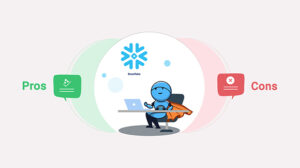There is a lot that goes into building a successful and impactful e-commerce business. Customers are a very critical pillar of any business, especially in an environment where so many choices are available to customers, and the cost of switching is zero.
However, customer analytics helps understand the customer’s needs and their behavior which can be achieved by tracking some of the key metrics and implementing simple but targeted strategies. Once you are tracking the correct data and metrics, you can start using the resulting customer insights to inform business decisions and improve acquisitions, retention, and loyalty.
Good leadership must have a different strategy to grow its customers in all segments – to execute these strategies efficiently; We need to understand customer analytics from all aspects. Here we’ll look at what customer analytics is all about and what makes it so crucial for e-commerce companies.
Active Customer Base
First of all, you must realize that your total customer base is not your active customer base. There is a significant chunk of customers who have lapsed and have not used your platform in recent times; such a chunk of your total base is called “inactive customer base” or “lapsed customer base”.
A customer who has used the platform or service in recent times can be considered an active customer and is highly likely to return. The duration for which a customer shall be considered active depends on the kind of service or product available on the platform. For example – A grocery selling platform may consider users active just for several weeks to a month, while an e-commerce company selling apparel may consider this duration as several months.
A top percentile of your loyal customer base is actually very important because they are not just the customers. They are the brand advocates. They refer to the brand as their connections simply based on their excellent experience in the past. This chunk of customers should be identified and given some rewards to further encourage them.
The active customers are highly likely to return to your platform, and two things matter the most while tracking the repeat potential of your customers:
1. The % of customers repeating and the frequency at which these customers are repeating (latency)
2. Month over month new acquired customer % vs repeat customer % (Behaviour of Consumers)
Extending the study of the behavior of repeat consumers using customer analytics, one should be aiming to find the answers to these key questions
- Why would any user convert to become a customer on my platform
- What can make that user come again for his/her next need
The answers to these key questions lie in understanding the behavior of different sets of users on the platform. Every customer has got his/her needs, interests, and limitations. One should always strive to understand these needs and limitations to provide a seamless and personalized experience to its users.
Typically, One Can Define a Few Variables for all the Customers to Understand the Customer Profile
- Discount Seeker - Customers who have mostly shopped in sales and have purchased products that were on heavy discounts
- Brand Affinity - For a multi-brand platform, each customer has a little or significant inclination toward a brand. This inclination or preference of a customer is called brand affinity.
- Sweet price point – For every category or type of product, the customer has a set budget on price. One should understand this price nuance while making its platform personalized for the users.
- Distinct Categories - For a multi-category platform, whether the customer has bought all the categories or how many of the total categories the customer has made purchases in
- Repeat Frequency - After how many days the customer comes back to the platform
After analyzing these customer profiles through customer analysis, one can target its customers aptly and provide them with exactly what they are looking for.
Digital Commerce Analytics: Why You Need It for Your Online Store
Digital commerce analytics is the process of collecting data from all areas that have an impact on your online store and utilizing this information to comprehend the trends and the change in consumers’ behavior to make data-driven decisions that will push more online sales.
Some of the benefits of digital commerce analytics are:
– You can identify your best-selling products, categories, and channels, and focus your resources on them.
– You can understand your customer journey, from acquisition to retention, and optimize each stage for conversion and loyalty.
– You can measure the effectiveness of your marketing campaigns, such as email, social media, SEO, and paid ads, and improve your return on ad spend (ROAS).
– You can discover new opportunities and insights that can help you grow your business and stay ahead of the competition.
Importance of Customer Insights for Ecommerce Businesses
Customer insights are the key to creating a successful ecommerce business. They help you understand who your customers are, what they want, how they behave, and how they feel about your brand.
Customer insights can help you:
– Segment your customers based on their demographics, preferences, behavior, and feedback, and tailor your marketing messages and offers accordingly.
– Personalize your customer experience by providing relevant product recommendations, content, and support across all touchpoints.
– Increase customer satisfaction and loyalty by exceeding their expectations and solving their pain points.
– Encourage customer advocacy by collecting reviews, testimonials, referrals, and social media mentions.
To gain customer insights, you need to collect data from various sources, such as:
- Your website analytics, such as Google Analytics or Shopify Analytics
- Your customer relationship management (CRM) system
- Your email marketing platform
- Your social media platforms
- Your customer feedback surveys
- Your customer reviews and ratings
By analyzing this data, you can uncover patterns and trends that can help you improve your customer-centricity and grow your ecommerce business.
Importance of Data Analytics in Ecommerce
Data analytics is the process of transforming raw data into meaningful information that can help you make better decisions for your ecommerce business.
Data analytics can help you:
- Identify problems and opportunities in your ecommerce operations
- Test hypotheses and validate assumptions
- Measure outcomes and evaluate results
- Optimize processes and performance
- Innovate and experiment with new ideas
To perform data analytics, you need to follow these steps:
- Define your business goals and questions
- Collect data from relevant sources
- Cleanse and prepare data for analysis
- Analyze data using diverse methods and tools
- Visualize and communicate data insights
By applying data analytics to your ecommerce business, you can gain a competitive edge and achieve your objectives faster.
Conversion
All of the marketing activities can bring the user to the platform but can not influence him/her to make a purchase. This is a major difference between in-store shopping and online shopping. Physical stores have sales executives which can help customers to find the right product hence influencing the customer’s buying decision. Online stores lack humans as sales executives, but it has their own set of upsides. To aid users to find what they want and eventually convert one may apply some personalized recommendations on the platform. Having personalization on the platform benefits e-commerce companies in various ways
- Generally, personalized results have a higher potential to make the customer purchase. This increases the platform conversion.
- Personalized results can also be used to upsell and cross-sell at the time of checkout or on product pages
- Retargeting campaigns can be designed by using personalized products, and customers can be brought back to the platform
Conclusion: Use Customer Analytics to Speed up Your Growth
Understanding customers’ behavior and needs helps boost the company’s overall performance. Leveraging customer analytics, which is a subset of data analytics can help us to serve our customers better. Data analytics and CRM usage help to understand every customer’s buying pattern. And helps enterprises to plan marketing strategies. Many analytics consulting firms have expertise in this field and have also developed analytics software created especially for e-commerce customer analytics. Partnering with such a firm is always a wise decision for the management of an e-commerce company. Businesses applying data analytics and CRM have often seen a huge jump in the overall revenue within a few years.
Saras, with its effective data management and analytics team, helps Brands across the globe to make informed data-driven decisions to accelerate growth. Use Customer Analytics to enhance your Business Strategies.













